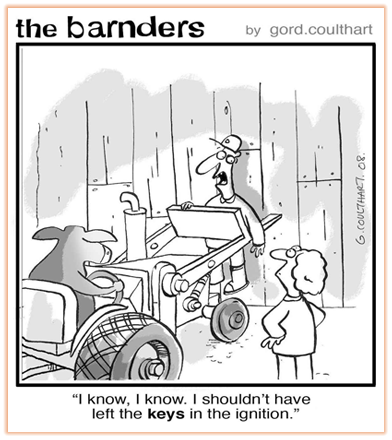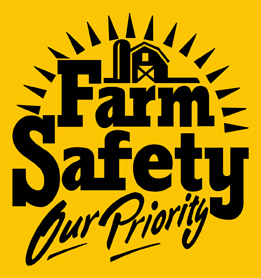Training Room 1: First Steps to Safety—Understanding Hazards
Session 1: Your Rights and Responsibilities for Workplace Safety

Courtesy of Gordon Coulthart and The Canadian Agricultural Safety Association
According to the Alberta Government's Workplace Health and Safety, workers under 25 are 33% more likely to be injured than older co-workers. Young workers in all industries need to be aware of hazards in their places of work. You have the right to expect hazards to be kept under control so that you and your co-workers are safe when working.
Learning Target
In this session you will identify your basic rights and responsibilities for general workplace safety. You will explore and identify the law as it applies to agricultural health and safety.
Do this by answering these questions:
- What do you believe are your fundamental rights and responsiblilites as a young worker when it comes to safety on the job?
- What are the legislation and exemptions for agricultural health and safety on Alberta farms?
You Have the Right to Be Safe!
Watch and Listen
Use these two resources to help you make some decisions about your personal health and safety in the workplace:
- Click the link to read information about the rights and responsibilities of new and young workers on Alberta's Safe and Fair Workplaces site. What are the 10 most important questions to ask your employer?
- Click the link to WorkSafeBC's Raise Your Hand website.
- Click on the Toolkit tab and watch the training videos on the website.
- Click on the Industry Vitals tab and compare the industry vitals charts to find out the statistics about young workers' injuries in a variety of industries, including agriculture.
- Click on the Toolkit tab and watch the training videos on the website.
Employer's Responsibilities and Your Rights
In Canada, it's the employer's responsibility to provide safety training and equipment to ensure worker safety. It's up to the employee, though, to make sure the or she can do the job safely. Working together to create and maintain a safe, productive working environment is the best bet.
Employers are required under Bill C-45 to do their best to keep their employees from harm. This means that employers should instruct their employees to complete tasks in the safest way possible, rather than a faster or more profitable way.
What can an employer do to provide a safe work environment?
- Provide complete safety training programs (training, safety equipment, safe environment and properly maintained and serviced equipment).
- Support management and supervisory staff in enforcing safety protocols.
- Have procedures in place for reporting unsafe conditions.
- Establish joint health and safety committees to inspect the worksite.
- Listen to reports from employees.
- Monitor operations to correct unsafe situations.
You Can Be Responsible for Yourself!
Your decisions about how you get involved in your own worksite safety are important. You have the right, but are not obligated by law, to maintain your safety and to have access to safety equipment and training.

Dynamic Graphics/liquidlibrary/Thinkstock
You have three basic rights as a worker:
1. You have the right to know about the hazards of your job. You should know how to recognize and deal with those hazards so they won't cause injury or health problems to you or others.
2. You have the right to participate in health and safety in the workplace. Your supervisor and employer should consult with you on matters that affect your safety as a worker. This makes sense because you, as a worker, perform the everyday tasks and face the hazards directly. You can point to health and safety situations you're concerned about.
3. You have the right to refuse work that you believe to be unusually dangerous to yourself or others. If an employee has reason to believe that a situation presents a danger, he/she can refuse to work. This is one of your most important rights–it can save your life.
Along with your rights, you have the following responsibilities:
- Demonstrate responsible behaviour. Take care of your health and safety and the health and safety of other workers who are affected by your actions.
- Practise safe work habits.
- Wear all appropriate personal protective equipment (PPE).
- Know how to use equipment properly. Use equipment the way it was intended to be used.
- Report unsafe conditions.
What are the legislation and exemptions for agricultural health and safety on Alberta farms?
How do health and safety regulations on a farm compare to other worksites?
There are three main sources of legislation related to workplace safety:

Courtesy of Gordon Coulthart and The Canadian Agricultural Safety Association
1. Occupational Health and Safety
Most farming operations in Alberta are currently exempt from Alberta's Occupational Health and Safety (OHS) Act. Because of this, when there are injuries or fatalities on a farm, there is no investigation by OHS representatives to help find ways to improve safety practices on the farm.
Bill C-45
This is federal legislation under Canadian Criminal Code that protects workers by establishing duties for workplace health and safety. Bill C-45 protects you as a worker but also requires that you take responsibilities, as stated above, to keep yourself and others safe on the job. As a result of Bill C-45, section 217.1 of the Criminal Code states:
"Everyone who undertakes, or has the authority, to direct how another person does work or performs a task is under a legal duty to take reasonable steps to prevent bodily harm to that person, or any other person, arising from that work or task."
More information can be found at http://www.ccohs.ca/oshanswers/legisl/billc45.html#_1_1.
Workers' Compensation
As a farm worker in Alberta, you are not necessarily covered by the insurance of the Workers' Compensation Act if injured. A farm owner can choose to purchase Workers' Compensation Board insurance or buy insurance through a private company for themselves and their employees. It is important to ask about insurance coverage. You can get individual insurance privately to help cover costs if you are injured on the job.
Alberta does have a Farm Safety Program website with links resources to help farmers and workers enhance their health and safety. Check the website for Worker Safety Fact Sheets to help you understand your rights and responsibilities.
Discuss
Rights and Responsibilities Discussion
Think about your own personal experiences around safety in your home and agricultural worksite.Think about the information you discovered while exploring the websites above.
- What do you believe are your fundamental rights and responsiblilites as a young worker when it comes to safety on the job?
- How can you best keep yourself safe as a worker?
Choose one of the following ways to share your responses to these questions:
- Contribute your thoughts to the online discussion and respond to one other student's posting in the Rights and Responsibilities Discussion.
OR
- Add your comments on this discussion to your journal or blog.
AND
- Use the Rhythmixer found on the Raise Your Hand website to create a safety message describing your safety rights, and share it with a classmate, family member, or co-worker.